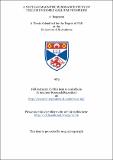Files in this item
A nuclear magnetic resonance study of tellurium doped gallium phosphide
Item metadata
| dc.contributor.advisor | Tunstall, D. P. (David Prestwich) | |
| dc.contributor.author | Rogerson, A. | |
| dc.coverage.spatial | 116 p. | en_US |
| dc.date.accessioned | 2018-06-28T13:57:22Z | |
| dc.date.available | 2018-06-28T13:57:22Z | |
| dc.date.issued | 1975 | |
| dc.identifier.uri | https://hdl.handle.net/10023/14716 | |
| dc.description.abstract | A study has been made of 7, LEC grown, tellurium doped gallium phosphide samples using pulsed nmr, Hall effect, and related measurements. The results have been correlated with nmr, esr, electron susceptibility, and transport measurements in similar systems, and changes which occur in the donor electron system in the intermediate doping region preceding the metallic transition have been discussed. The effects which these changes have on the nuclear relaxation times of the host nuclei have been discussed in terms of the various stages of nuclear relaxation by spin diffusion to paramagnetic impurities. In the lightly doped samples, rapid diffusion and diffusion limited relaxation processes have been identified around the minima in the T₁:T curves of the P³¹ , and two Ga isotopes respectively. The effects on nuclear relaxation of the preferential distribution of the Te donor wavefunction on P³¹ sites have been discussed. Experimental calculations of the Ga⁶⁹ and Ga⁷¹ spin diffusion coefficients have been made and compared with values derived from spin diffusion theory. T₁ results from the more heavily doped samples have been discussed in terms of the various models of the state of the electron system in the intermediate doping region. Evidence of the increasing importance of electron spin-spin interactions and diffusion vanishing relaxation processes have been obtained from the concentration, magnetic field, and temperature dependences of the T₁'s of all three isotopes at low temperatures. Hall and conductivity measurements reflected the reduction in donor ionisation energy with increasing donor concentration in the intermediate doping region, and the observed movement of the position of the T₁ minima to lower temperatures in the same samples have been taken as further evidence of this effect. Calculations of the donor ionisation energy have been made from analysis of the temperature dependence of the Ga⁶⁹ and Ga⁷¹ T₁'s around the T₁ minima and from the variation of the position of the minimum with frequency. The weakening and eventual disappearance of the T₁ minima in the most heavily doped samples have been discussed in terms of the reduction in the effectiveness of nuclear relaxation to single paramagnetic impurities as impurity hopping and spin-spin effects increase. The enhanced magnetic field dependence and increase in T₁ observed in the most heavily doped samples at low temperatures have been taken as evidence for the incomplete delocalisation of the donor electron system in these samples. | en_US |
| dc.language.iso | en | en_US |
| dc.publisher | University of St Andrews | |
| dc.subject.lcc | QD181.G2R7 | |
| dc.subject.lcsh | Gallium | en |
| dc.title | A nuclear magnetic resonance study of tellurium doped gallium phosphide | en_US |
| dc.type | Thesis | en_US |
| dc.type.qualificationlevel | Doctoral | en_US |
| dc.type.qualificationname | PhD Doctor of Philosophy | en_US |
| dc.publisher.institution | The University of St Andrews | en_US |
This item appears in the following Collection(s)
Items in the St Andrews Research Repository are protected by copyright, with all rights reserved, unless otherwise indicated.

